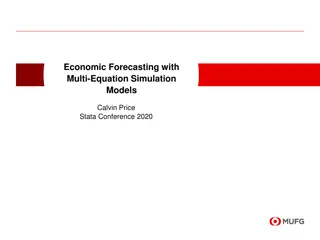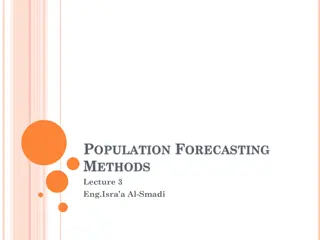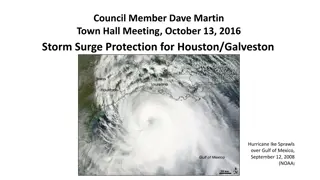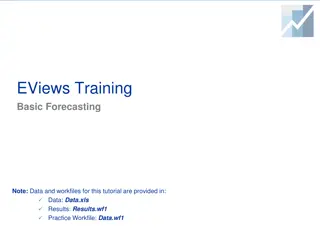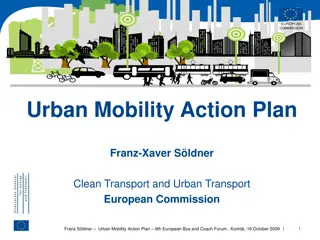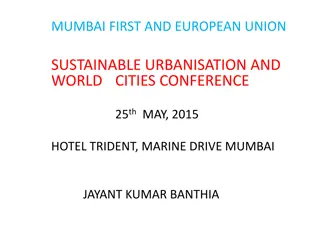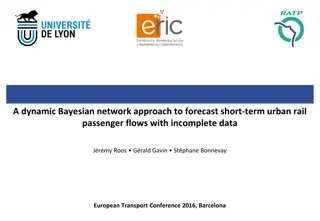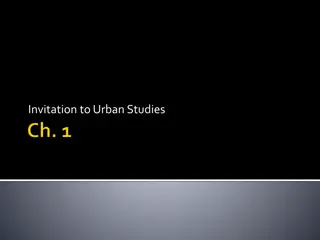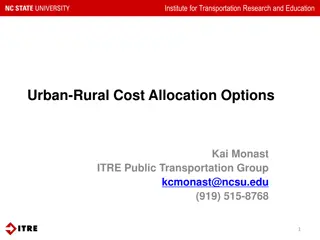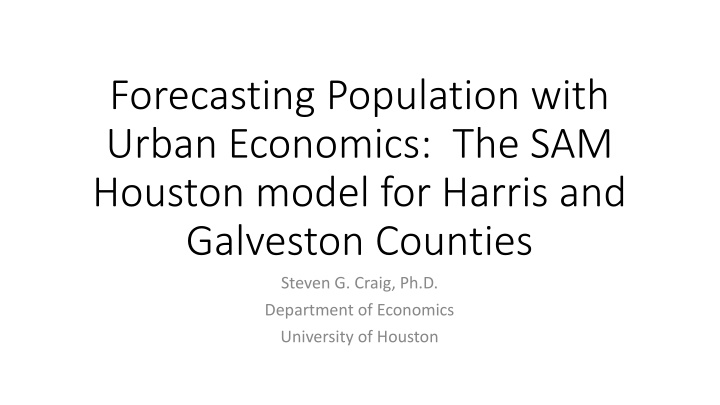
Forecasting Population Allocation Using Urban Economics in Harris & Galveston Counties
Develop a long-run forecasting model based on urban economics theory to distribute population across the metro area until 2100. Utilize census data and explore how employment shapes cities, focusing on agglomeration economies and population density factors. Investigate the effect of agglomeration on land prices and population distribution, exemplified by the Houston linear density function.
Download Presentation

Please find below an Image/Link to download the presentation.
The content on the website is provided AS IS for your information and personal use only. It may not be sold, licensed, or shared on other websites without obtaining consent from the author. If you encounter any issues during the download, it is possible that the publisher has removed the file from their server.
You are allowed to download the files provided on this website for personal or commercial use, subject to the condition that they are used lawfully. All files are the property of their respective owners.
The content on the website is provided AS IS for your information and personal use only. It may not be sold, licensed, or shared on other websites without obtaining consent from the author.
E N D
Presentation Transcript
Forecasting Population with Urban Economics: The SAM Houston model for Harris and Galveston Counties Steven G. Craig, Ph.D. Department of Economics University of Houston
Objective Develop a Long Run Forecasting Model that allocates population across the metro area- out to the year 2100! To do so, we use urban economics theory to understand how population is distributed. The theory we use is based on employment Maybe Houston specific- we are here in Houston because of work, not great weather and beautiful mountains!
Our Forecast Depends on Census Data: Using Census Tracts as the Unit of Geography Census Blocks only to convert between years One interesting fact: The ACS is supposed to be improved, and be useful at the tract level We did some general analysis of the ACS data, and it looked pretty good initially. We used ACS 2019 to assess our 2010 forecasts When the 2020 Census data came out, my assistant said to me: Boy, your 2010 forecasts look a lot better! The ACS has not been good on migration, and apparently it still is not- Although the census tract allocations of their bad forecasts seems decent
Urban Economics: How Employment Shapes a City Especially Ours The basic structure is that employers want to locate together Because of Agglomeration Economies That is, firm profits are higher when firms locate near each other Due to access to employees Access to customers- other firms and local labor Transfer of technology (people talk) Concentration of infrastructure- and many other possibilities
Effect of Agglomeration on People Because firms have demand to locate together, they bid up land prices So theoretically, all firms would locate downtown And people would want to be near firms, to keep their commuting costs down Thus land farther from downtown, or central business district, would be cheaper than land close to the CBD Result is called a density function : It describes the relationship between distance to the CBD and population density as:
Houston Linear Density Function: Land Density Falls as Land Prices Fall
Response to Demand for Location in the CBD Congestion in the CBD- which raises costs So the market response has been to create employment sub-centers Galleria, Medical Center, Energy Corridor, Clear Lake, up to 16. Not industry concentrations. We find subcenters generally mirror downtown (vs. real estate names!) On average, employment is still closer to downtown than are residents- so most commuting is inward That is, residents only commute outward for personal circumstances The resulting density function for residents is therefore altered
The Cubic Spline Density Function In Houston, we have had some success at summarizing the resulting location of our employment subcenters We estimate a cubic spline function, which shows Houston s shape This is simply a generalization, think of each point on the graph as being a concentric circle around the CBD The low points of residential density suggest that is where employment concentrations outside of downtown occur- or Employment Subcenters
Cubic Spline Density Function Employment Subcenters at local nadirs Think about concentric circles around CBD
Employment Subcenters We have done some academic work on employment subcenters, and how they affect the shape of the urban economy Subcenters are pervasive in cities across the US- and even the world Of course their location depends on local topography But also on the built infrastructure- like highways We have also found that their location is important for determining where Houston residents live If one person works Downtown, and the other in the Galleria, then between them is superior to a Clear Lake location! And vice versa if the other person works in Clear Lake instead of the Galleria
Academic Qualifiers on Employment Subcenters There is not an agreed upon definition Everyone agrees the definition should include their size in terms of total employment, or share- especially conditional on distance from the CBD The more controversial part is whether the definition should be required to have influence on surrounding areas We have published work which supports this view- and we utilize this definition to inform our forecasts Which implies people are willing to pay to be closer to the subcenter, holding constant distance to the CBD And as a result, the subcenters have varied influences on each other- although we don t yet incorporate this in our forecasts
Forecast is Based on Rotation of Density Functions The next question is how to develop a forecast. Over time, the density function for the city rotates outward as total population grows Pivot around the point at the CBD (zero distance) Downtown residential density in Houston has been affected by City of Houston subsidy to residential construction Unimportant for overall economic shape The close-in areas develop by in-fill, and redevelopment Overall, the city grows faster in the outlying areas Land is cheaper No demolition is required This makes the city expand its boundaries as transportation improves, and the density function becomes flatter
Forecasting Statistical Module We use Census data from 1970-2020, and statistically estimate the density functions each decade to understand how they have rotated over time Based on the resulting pattern, we forecast how the density function will rotate in the future The advantage of this process is greater accuracy Forecasts more rapid development in areas farther from the CBD And the employment subcenter location suggests where growth is most rapid along the radii projecting from the CBD
Forecasting Land Use Module As you all know, history matters. In Economics, we call it fixed costs Parks, large facilities, and other locally-specific land uses impact population at the Census tract level The second part of our analysis develops what we call the Land Use Module We essentially convert the statistical forecasts into percent change, to be sensitive to the current land uses And sensitive to the control totals for each County (generated separately) Then we examine the potential forecast with respect to the vacant land available, using area specific residential densities If there is insufficient land to hold both the employment and population forecast, we use an algorithm to push people around to where there is available vacant land
Land Use Module, (cont) The information from the urban economics focus is important for suggesting alternative locations Specifically, to be sensitive to price, people will be about equi-distant from the CBD Which is telling you that distance to the CBD is still most important everywhere But, we find distance to the Galleria is also widely important Other employment subcenters have much smaller areas of influence And to be sensitive to the employment center locations, they will want to be near the appropriate radii.
Long Range Forecasting Our process assumes the basic structure of the city stays about the same over time I mentioned that we were asked to forecast out to the year 2100 Will the city economic structure stay the same this entire century? Simple answer, No. Why? 3 Parts 1. Drop in demand for petroleum exploration 2. Transportation Demand will Fall- batteries are made elsewhere 3. Sea Level Rise, plus storms become more frequent and more severe Though this impact depends crucially on public policy on infrastructure
Changes to Economic Structure: Reduction from Petroleum Part I of 3 part answer: Manufacturing on the East Side, and traffic at the Port of Houston, are largely driven by the petroleum industry Especially exploration- drilling equipment, pipe (where Houston supplies the world) And oil exploration is going to decline, probably by a lot We don t seem to have another major export industry waiting in the wings Export industries import wealth into the City And the alternative energy industries are not front and center here Public Policy: New Industrial Development Both U of H and Rice are pushing on this front
Long Range Structure: What Powers Transportation? Part II of why the economic structure of Houston will change Transportation uses about 70% of total worldwide petroleum production The aggregate investment by auto manufacturers in battery technology is staggering; easily $200 Billion this decade alone And you can already see the large number of Electric models coming out So even if global warming doesn t happen (it is), cars will be electric Doesn t mean petroleum demand goes to zero, but drastically reduced, and heading smaller over time And, batteries don t get made here in Houston
Part III of Long Run Change: Climate and Sea Level Rise Concern over Emissions will reduce demand for Petroleum And like batteries, we have not developed responses in our local economy More pertinent for our model are: Floodplains will become more important- either for damage (ex post), or for prevention infrastructure (ex ante)- but still costs rise Also increase in demand for emergency management infrastructure- flood control- and potentially local costs Both of which will influence location of Population Flood Control and other Emergency Management polices matter
Impacts of Potential Economic Decline We studied several post-industrial cities in the US Pittsburgh, Cleveland (OH), St. Louis, Birmingham And found the central city/central county of these metro areas declined in population over several decades Surprisingly to us, suburbs experienced continued (slower) growth We applied this pattern to post 2050 Houston. The central area is virtually constant, but the suburbs continue to grow This suggests to us a public policy problem with central cities being resilient- a subject of our continuing research
Policy Impacts on Houstons Future All of this environmental and economic stress will influence location The SAM-Houston model tries to incorporate the stress in two ways Additionally to the flat-interior-growing-suburbs pattern above Floodplains Using current data, people try to avoid 100 year Floodplains Surprisingly, 500 year floodplains are attractive We think this is reflecting relative value So our model allows the area in the 100 year floodplain to expand over time, while the area in the 500 year floodplain decreases. This is just a swap, we didn t add new areas to the floodplain although that would be a useful innovation
Long Run Accommodations Our second step for climate accommodation is that Brazoria County opted out of the newly created Coastal Protection District =Brazoria will not be part of the Ike Dike No local taxes in Brazoria to pay the local share, but everywhere else But, no protection from sea level rise and its consequences in Brazoria Thus our model pushed people away from coastal Brazoria This accommodation is almost for sure either: Too big (the Ike Dike is much more expensive than forecast) Too small- the Ike Dike works like a charm, and Brazoria has no protection
Summary and Conclusion For Forecasting, You never know what is going to happen next! But, it provides a great opportunity to think about where we are going as a region We have some serious long run challenges that are only slowly penetrating the public policy sphere- but the changes are positive My other conclusion is that economics is an important additional tool that could be incorporated in growth forecasting more often Especially in situations where the local areas of relative growth are important
Thank you! Steven Craig, Department of Economics, University of Houston scraig@uh.edu



